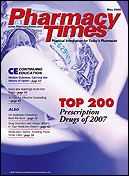Close Call: Not the Proper Mix
Proper reaction to near misses is essential in preventing medication errors, and this column features useful advice on developing systembased, error-reduction strategies.
Dr. Gaunt is a medication safety analyst and the editor of ISMP Medication Safety Alert! Community/Ambulatory Care Edition.
A patient?s father arrived at a community pharmacy to pick up an antibiotic, amoxicillin suspension 250 mg/5 mL, for his child. Unmixed amoxicillin powder, however, was dispensed. When he got home, the father measured 9 mL of powder, not 9 mL of liquid as intended by the instructions on the pharmacy-generated label. After administering the powder to his child, the father thought it was unusual that it was a powder rather than a liquid medication and called the pharmacy. It was then discovered that the patient received 9 g of amoxicillin in 1 dose instead of the intended 450 mg.
What Went Wrong?
The pharmacy where this event occurred follows a process to prepare and dispense reconstituted medications that is practiced in many pharmacies across the country. The antibiotic is pulled from the shelf, and the pharmacy-generated label is attached. The pharmacist then verifies the prescription and medication and bags the medication with a ?mix card? that informs the clerk that the medication requires mixing. The medication is then left in the ?will call? area until the patient comes to pick it up. Once the patient arrives at the pharmacy, the medication is reconstituted and dispensed.
On the day of this event, however, a new pharmacist neglected to bag the prescription with the mix card. The clerk who dispensed the medication also was new and not familiar with the mix-card procedure. The clerk gave the unmixed medication to the patient?s father. It appears from the report that no pharmacist consultation occurred.
The Pharmacists? Responses
The pharmacist who reported this event discussed this medication error with a few of his colleagues. The response he received is interesting and probably not all that uncommon. Most stated that they had witnessed this type of medication error previously or were aware of it occurring with some regularity. The pharmacists were not all that concerned, however, because it seemed that the error was easily identified by the patient, and, once it had been identified, the patient would generally return to the pharmacy. They also commented that the reason the error is not generally reported is that the situation is typically remedied before exposure and thus regarded as a near miss. In this particular situation, that was not the case. (Please note that the Institute for Safe Medication Practices does not agree with the way of thinking expressed by the pharmacists surveyed above.)
Error-prevention Tips
Simply relying on a reminder placed on or with the bag is not enough. A near miss should be evidence that a serious event could occur. Evaluate your systems for reporting and sharing near misses. Develop system-based, error-reduction strategies when actual errors or near misses are identified.
Consider placing new prescriptions for oral, liquid medications, especially those that need to be reconstituted, in a separate area from other prescriptions waiting to be picked up. Label the area not to be dispensed without speaking to the pharmacist.
This may help remind staff that the product needs to be mixed and that a pharmacist should review directions with the patient or caregiver.
Review the label and directions for use with the patient. Ensure that oral syringes (without caps) or other appropriate measuring devices are readily available with the product or for purchase at your practice site. Provide education to patients and caregivers regarding proper use of the measuring device. Demonstrate how to measure and administer the dose, and inform patients how to clean the device, if it is to be reused. In the case mentioned above, effective counseling would likely have stopped this error from reaching the child.
Subscribe to Newsletter
Pharmacy Times and the Institute for Safe Medication Practices (ISMP) would like to make community pharmacy practitioners aware of a publication that is available.
The ISMP Medication Safety Alert! Community/Ambulatory Care Edition is a monthly compilation of medication-related incidents, error-prevention recommendations, news, and editorial content designed to inform and alert community pharmacy practitioners to potentially hazardous situations that may affect patient safety. Individual subscription prices are $48 per year for 12 monthly issues. Discounts are available for organizations with multiple pharmacy sites. This newsletter is delivered electronically. For more information, contact ISMP at 215-947-7797, or send an e-mail message to
linkEmail('community','ismp.org');
.

